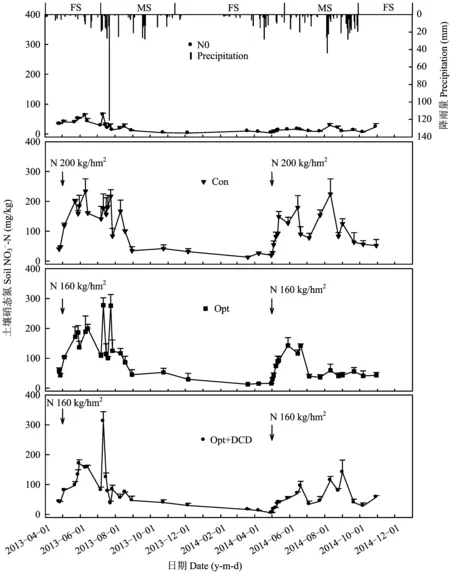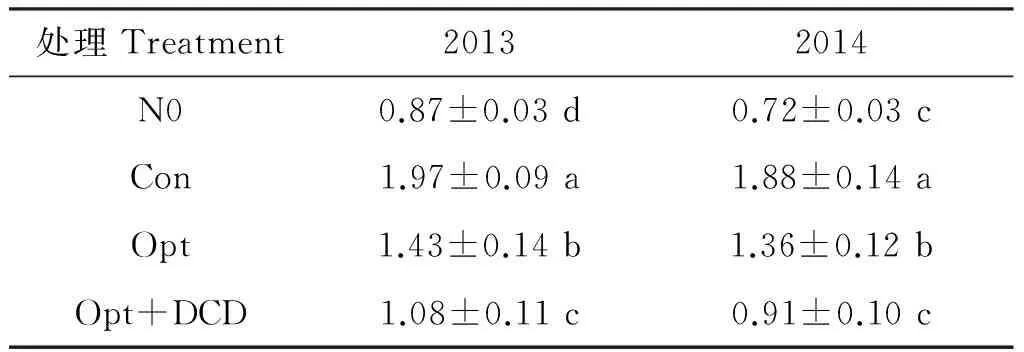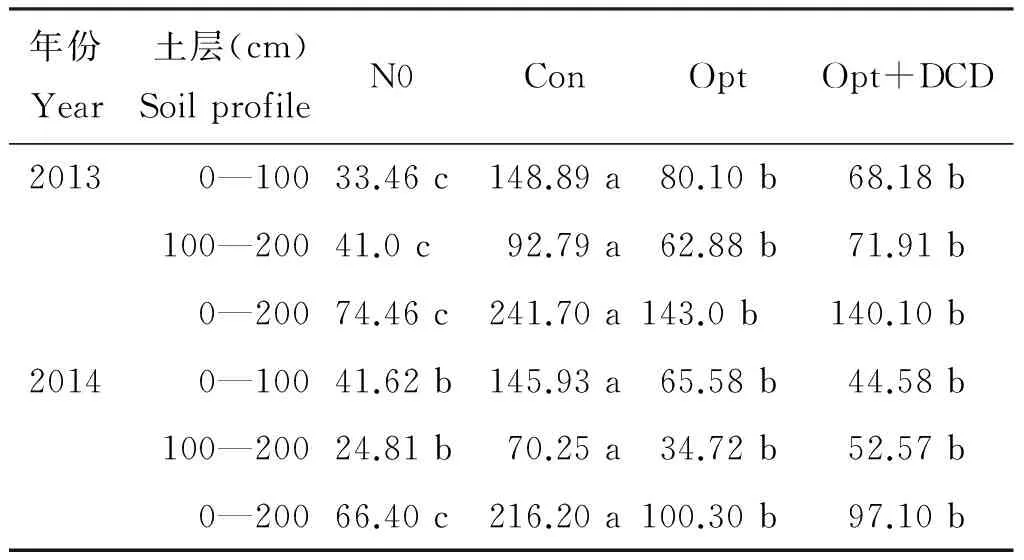添加DCD对雨养区春玉米产量、 氧化亚氮排放及硝态氮残留的影响
2016-08-24吴得峰姜继韶王志齐党廷辉郭胜利巨晓棠
吴得峰, 姜继韶, 高 兵, 刘 燕, 王 蕊, 王志齐,党廷辉,,*, 郭胜利,,, 巨晓棠*
(1西北农林科技大学资源环境学院,杨凌 712100; 2中国农业大学资源与环境学院,北京100193;3中国科学院水利部水土保持研究所,杨凌 712100; 4西北农林科技大学水土保持研究所,杨凌 712100)
添加DCD对雨养区春玉米产量、 氧化亚氮排放及硝态氮残留的影响
吴得峰1, 姜继韶3, 高 兵2, 刘 燕2, 王 蕊1, 王志齐4,党廷辉1,3,4*, 郭胜利1,3,4, 巨晓棠2*
(1西北农林科技大学资源环境学院,杨凌 712100; 2中国农业大学资源与环境学院,北京100193;3中国科学院水利部水土保持研究所,杨凌 712100; 4西北农林科技大学水土保持研究所,杨凌 712100)



1 材料与方法
1.1试验地概况

1.2试验设计与管理

1.3测定项目与方法
具体措施为:利用网络技术进行电力网格的程序设计,构建数据网格和信息网格,整合电力系统现有的数据和资源,实现数据在不同区域调度中心的交换和计算。电力网格的设置可以实现内网和外网的采用同一操作系统的运作模式,能在很大程度上提高电网运行的效率。

1.3.2 产量测定玉米收获时期,每个小区选取16 m2(共90株玉米),掰下玉米后称重,然后从中选取15个(能代表本小区实际情况)带回脱粒后自然风干,称重,计算籽实产量。

1.4计算方法与数据分析


氮肥农学效率[N agronomic efficiency(AE),kg/kg]=(施氮区产量-不施氮区产量)/施氮量[27];
N2O排放通量[F,μg/(m2·h)]=(273×M×60/10×H)/[22.4×(273+T)]×dc/dt其中, 22.4为温度为273K时的N2O摩尔体积(L/mol); T(℃)为盖箱时间内平均大气温度; M(28)代表每摩尔N2O中N2的分子量; H为采样箱高度(cm),c为N2O气体浓度(μL/L); t为关箱时间(min); dc/dt为采样箱内N2O气体浓度的变化率[μL/(L·min)]; dc/dt(t=0)是指曲线在0时刻的初始斜率[28]。
2 结果与分析
2.1施氮模式对玉米产量和氮肥农学效率的影响


表1 施肥模式对玉米籽粒产量和氮肥农学效率的影响Table 1 Effects of fertilization modes on grain yields and several agronomic indexes of corn
注(Note): NEA—氮肥农学效率 N agronomic efficiency; PEP—氮肥偏生产力Partial efficiency of N; 同列数据后不同字母表示差异达5%显著水平Values followed by different letters in a column are significantly different among treatments at 5% level.
2.2施氮模式对土壤表层矿质氮动态变化的影响

图1 施氮模式对土壤表层硝态氮动态变化的影响Fig.
[注(Note): FS—休闲季Fallow season; MS—玉米生长季Maize season; 箭头代表施肥时间Arrows represent the time of fertilization.]
2.3施氮模式对土壤氧化亚氮排放的影响
施氮显著增加了4种施氮模式的氧化亚氮的排放速率(P<0.05)(图3),在施氮后的10天内N2O排放速率维持在一个较高水平,10天以后显著降低。

图2 施氮模式对土壤表层铵态氮动态变化的影响Fig.2 Dynamic in -N in topsoil (0—20 cm) under the N fertilization practices
[注(Note): FS—休闲季Fallow season; MS—玉米生长季Maize season; 箭头代表施肥时间Arrows represent the time of fertilization.]



图3 不同施氮模式土壤氧化亚氮排放动态变化Fig.3 Dynamic in N2O under different N fertilization modes
2.4施氮模式对土壤剖面硝态氮残留的影响


表2 施氮模式对土壤氧化亚氮排放年累积量的影响(kg/hm2)Table 2 Cumulative N2O emission under the N fertilization practices
注(Note): 同列数据后不同字母表示差异达5%显著水平 Values followed by different letters are significantly different among treatments at 5% level.
表3不同施氮模式土壤0—200 cm剖面硝态氮残留量(kg/hm2)
profile under different N fertilization modes

注(Note): 同列数据后不同字母表示差异达5%显著水平 Values followed by different letters are significantly different among treatments at 5% level.
3 讨论

4 结论
1)减量施氮模式在施氮量减少20%的同时,并没有显著降低玉米产量,反而提高了氮肥偏生产力(32%)和氮肥农学效率(27%)。

因此,在黄土高原雨养农业区使用DCD是一种保产、 减氮、 减排的有效措施,也是一种科学有效的施肥管理方式。
[1]Dawar K, Zaman M, Rowarth J S,etal. Urea hydrolysis and lateral and vertical movement in the soil: Effects of urease inhibitor and irrigation [J]. Biology and Fertility of Soils,2011, 47(2): 139-146.
[2]习金根, 周建斌. 不同灌溉施肥方式下尿素态氮在土壤中迁移转化特性的研究[J]. 植物营养与肥料学报, 2003, 9(3): 271-275.
Xi J G, Zhou J B. Leaching and transforming characteristics of urea-N added by different ways of fertigation[J]. Plant Nutrition and Fertilizer Science, 2003, 9(3): 271-275.
[3]戴宇, 贺纪正, 沈菊培. 双氰胺在农业生态系统中的应用效果及其影响因素[J]. 应用生态学报, 2014, 25(1): 279-286.
Dai Y, He J Z, Shen J P. Effects and influence factors of dicyandiamide(DCD) application in agricultural ecosystem [J]. Chinese Journal of Applied Ecology, 2014, 25(1): 279-286.
[4]李伟, 李絮花, 唐慎欣, 等. 控释掺混肥对夏玉米产量及土壤硝态氮和铵态氮分布的影响[J]. 水土保持学报, 2011, 25(6): 68-91.
Li W, Li X H, Tang S X,etal. Effect of controlled-release urea combined with common urea on the grain yields of summer maize and distribution of soil ammonium and nitrate content[J]. Journal of Soil Water Conservation, 2011, 25(6): 68-91.
[5]刘瑜, 串丽敏, 安志装, 等. 硝化抑制剂双氰胺对褐土中尿素转化的影响[J]. 农业环境科学学报, 2011, 30(12): 2496-2502.
Liu Y, Chuan L M, An Z Z,etal. Effects of nitrification inhibitor dicyandiamide on ammonium and nitrate nitrogen transformations in cinnamon soil[J]. Journal of Agro-Environment Science, 2011, 30(12): 2496-2502.
[6]孙志梅, 武志杰, 陈利军, 马星竹. 硝化抑制剂的施用效果、 影响因素及其评价[J]. 应用生态学报, 2008, 19(7): 1611-1618.
Sun Z M, Wu Z J, Chen L J, Ma X Z. Application effect,affecting factors,and evaluation of nitrification inhibitor [J]. Chinese Journal of Applied Ecology, 2008, 19(7): 1611-1618.
[7]曾后清, 朱毅勇, 王火焰, 沈其荣. 生物硝化抑制剂—一种控制农田氮素流失的新策略[J]. 土壤学报, 2012, 49(2): 382-388.
Zeng H Q, Zhu Y Y, Wang H Y, Shen Q R. Biological nitrification inhibitor-A new strategy for controlling nitrogen loss from farmland [J]. Acta Pedologica Sinica, 2012, 49(2): 382-388.
[8]刘倩, 褚贵新, 刘涛, 等. DCD在不同质地土壤上的硝化抑制效果和剂量效应研究[J]. 中国生态农业学报, 2011, 19(4): 765-770.
Liu Q, Chu G X, Liu T,etal. Nitrification inhibition and dose-dependent effect of dicyandiamide on sandy,loamy and clayey soils [J]. Chinese Journal of Eco-Agriculture. 2011, 19(4): 765-770.
[9]俞巧钢, 陈英旭. 尿素添加硝化抑制剂DMPP对稻田土壤不同形态矿质态氮的影响[J]. 农业环境科学学报, 2011, 30(7): 1357-1363.
Yu Q G, Chen Y X. Effect of the urea with nitrification inhibitor DMPP addition on different form nitrogen transformation in rice fields [J]. Journal of Agro-Environment Science, 2011, 30(7): 1357-1363.
[10]孙爱文, 石元亮, 朱志锋, 尹宏斌. 硫脲及抑制剂组合对土壤尿素氮转化和玉米产量的影响[J]. 植物营养与肥料学报, 2005,11(4): 481-486.
Sun A W, Shi Y L, Zhu Z F, Yin H B. Effect of combination of thiourea and inhibitors on soil urea-N transformation and corn yield [J]. Plant Nutrition and Fertilizer Science, 2005, 11(4): 481-486.
[11]华建峰, 蒋倩, 施春健, 等. 脲酶/硝化抑制剂对土壤脲酶活性、 有效态氮及春小麦产量的影响[J]. 土壤通报, 2008, 39(1): 94-99.
Hua J F, Jiang Q, Shi C J,etal. Effects of urease/nitrification inhibitors on soil urease activity,soil available N and the yield of spring wheat [J]. Chinese Journal of Soil Science, 2008,39(1): 94-99.
[12]张志明, 李继云, 冯元琦, 等. 长效碳酸氢铵理化特性及增产机理的研究[J]. 中国科学(B辑化学), 1996, 26(5): 452-459.
Zhang Z M, Li J Y, Feng Y Q,etal. Study of physical and chemical properties and yield mechanism on durably efficacious ammonium bicarbonate[J]. Science in China(Series B), 1996, 26(5): 452-459.
[13]赵伦学, 肖厚军. 硝化抑制剂对白菜产量和硝酸盐含量的影响[J]. 农技服务, 2014, 31(6): 119-124.
Zhao L X, Xiao H J. Effects of nitrification inhibitors on the yield of cabbage and the content of nitrate [J]. Agricultural Machinery Service, 2014, 31(6): 119-124.
[14]Malla G, Bhatia A, Pathak H,etal. Mitigating nitrous oxide and methane emissions from soil in rice-wheat system of the indo-gangetic plain with nitrification and urease inhibitors [J]. Chemosphere, 2005, 58(2): 141-147.
[15]李香兰, 徐华, 蔡祖聪. 氢醌、 双氰胺组合影响稻田甲烷和氧化亚氮排放研究进展[J]. 土壤学报, 2009, 46(5): 917-924.
Li X L, Xu H, Cai Z C. Effect of combined use of hydroquinone and dicyandiamide on CH4and N2O emissions from rice paddy field [J]. Acta Pedologica Sinica, 2009, 46(5): 917-924.
[16]石美, 梁东丽, 满楠, 等. 不同浓度DMPP和DCD对石灰性土壤中氮素转化的影响[J]. 中国农业科学, 2012, 45(22): 4635-4642.
Shi M, Liang D L, Man N,etal. Effcts of different application rates of DMPP and DCD on nitrogen transformation in calcareous soil [J]. Scientia Agricultura Sinica, 2012, 45(22): 4635-4642.
[17]杨春霞, 李永梅. 双氰胺对不同质地红壤中尿素的硝化抑制作用研究[J]. 中国生态农业学报, 2006, 14(2): 111-113.
Yang C X, Li Y M. Nitrification inhibition of dicyandiamide on urea in the red soil of different textures[J]. Chinese Journal of Eco-Agriculture. 2006, 14(2): 111-113.
[18]Kawakami E M, Oosterhuis D M, Snider J L,etal. Physiologi-
cal and yield responses of field-grown cotton to application of urea with the urease inhibitor NBPT and the nitrification inhibitor DCD [J]. European Journal of Agronomy, 2012, 43: 147-154.
[19]李卓勇, 梁家作. 双氰胺对赤红壤中氯化铵硝化抑制效应研究[J]. 南方农业学报, 2011, 42(10): 1238-1240.
Li Z Y, Liang J Z. The inhibitory effect of dicyandiamide on nitrification in latosolic red soil [J]. Journal of Southern Agriculture, 2011, 42(10): 1238-1240.
[20]何盈, 蔡顺香, 何春梅, 罗涛. 施氮量和DCD对蕹菜生长、 硝酸盐累积及土壤氮素形态的影响[J]. 北方园艺, 2007(12): 10-13.
He Y, Cai S X, He C M, Luo T. Effects of nitrogen rate and DCD on growth,nitrate accumulation of the water spinach and soil nitrogen [J]. Northern Horticulture, 2007(12): 10-13.
[21]Guobin L. Soil conservation and sustainable agriculture on the loess plateau: Challenges and prospects [J]. Ambio, 1999, 28(8): 663-668.


[23]李军, 王立祥, 邵明安, 樊延录. 黄土高原地区玉米生产潜力模拟研究[J]. 作物学报, 2002, 28(4): 555-560.
Li J, Wang L X, Shao M A, Fan Y L. Simulation of maize potential productivity in the Loess Plateau Region of China [J]. Acta Agronomica Sinica, 2002, 28(4): 555-560.
[24]党廷辉, 郭胜利, 郝明德. 黄土旱塬长期施肥下硝态氮深层累积的定量研究[J]. 水土保持研究, 2003, 10(1): 58-75.



[26]石德杨, 张海艳, 董树亭. 土壤高残留氮条件下施氮对夏玉米氮素平衡、 利用及产量的影响[J]. 植物营养与肥料学报, 2013, 19(1): 37-44.
Shi D Y, Zhang H Y, Dong S T. Effects of nitrogen application on nitrogen balance and use efficiency and yield of summer maize in soil with high residual nitrogen[J]. Plant Nutrition and Fertilizer Science, 2013, 19(1): 37-44.
[27]张福锁, 王激清, 张卫峰, 等. 中国主要粮食作物肥料利用率现状与提高途径[J]. 土壤学报, 2008, 45(5): 915-924.
Zhang F S, Wang J Q, Zhang W F,etal. Nutrient use efficiencies of major cereal crops in China and measures for improvement [J]. Acta Pedologica Sinica, 2008, 45(5): 915-924.
[28]Kroon P S, Hensen A,van den Bulk W C M,etal. Theimportance of reducing the systematic error due to non-linearity in N2O flux measurements by static chambers [J]. Nutrient Cycling in Agroecosystems, 2008, 82(2): 175-186.
[29]Khalil M I, Gutser R, Schmidhalter U. Effects of urease and nitrification inhibitors added to urea on nitrous oxide emissions from a loess soil [J]. Journal of Plant Nutrition and Soil Science, 2009, 172(5): 651-660.
[30]蔡延江, 丁维新, 项剑. 土壤N2O和NO产生机制研究进展[J]. 土壤, 2012, 44(5): 712-718.
Cai Y J, Ding W X, Xiang J. Mechanisms of nitrous oxide and nitric oxide production in soils: A review [J]. Soils, 2012, 44(5): 712-718.
[31]Ma B, Wu T, Tremblay N,etal. Nitrous oxide fluxes from corn fields: On-farm assessment of the amount and timing of nitrogen fertilizer [J]. Global Change Biology, 2010, 16(1): 156-170.
[32]Halverson L J, Jones T M, Firestone M K. Release of intracell-
ular solutes by four soil bacteria exposed to dilution stress [J]. Soil Science Society of America Journal, 2000, 64(5): 1630-1637.
[33]Beare M H, Gregorich E G, St-Georges P. Compaction effects on CO2and N2O production during drying and rewetting of soil [J]. Soil Biology & Biochemistry, 2009, 41(3): 611-621.
[34]Liu X J, Ju X T, Zhang F S,etal. Nitrogen dynamics and budgets in a winter wheat-maize cropping system in the North China Plain [J]. Field Crops Research, 2003, 83(2): 111-124.
[35]高素玲, 刘松涛, 杨青华, 常介田. 氮肥减量后移对玉米冠层生理性状和产量的影响[J]. 中国农学通报, 2013, 29(24): 114-118.
Gao S L, Liu S T, Yang Q H, Chang J T. Effect of reducing and postponing nitrogen fertilization on the yield and canopy physiological properties of corn [J]. Chinese Agricultural Science Bulletin, 2013, 29(24): 114-118.
[36]Liu J, Zhu L, Luo S,etal. Response of nitrous oxide emission to soil mulching and nitrogen fertilization in semi-arid farmland [J]. Agriculture, Ecosystems & Environment, 2014, 188: 20-28.
Effects of DCD addition on grain yield, N2O emission and residual nitrate-N of spring maize in rain-fed agriculture
WU De-feng1, JIANG Ji-shao3, GAO Bing2, LIU Yan2, WANG Rui1, WANG Zhi-qi4,DANG Ting-hui1,3,4*, GUO Sheng-li1,3,4, JU Xiao-tang2*
(1CollegeofResourcesandEnvironment,NorthwestA&FUniversity,Yangling,Shaanxi712100,China; 2CollegeofResourcesandEnvironmentalSciences,ChinaAgriculturalUniversity,Beijing100193,China; 3InstituteofSoilandWaterConservation,ChineseAcademyofSciencesandMinistryofWaterResources,Yangling,Shaanxi712100,China; 4InstituteofSoilandWaterConservation,NorthwestA&FUniversity,Yangling,Shaanxi712100,China)
【Objectives】The impacts of nitrate inhibitor (dicyandiamide, DCD)on crop yields and residuals of soil nitrate N in field have been less reported under field condition. It is of great importance to research its effects in different nitrogen (N) fertilization modes for high maize yield, low N2O emission and high fertilizer-nitrogen use efficiency.【Methods】A field experiment was conducted in the Changwu State Key Agro-Ecological Station from April 2013 to September 2014. Pioneer 335, a high-yield spring maize hybrid, was chosen and planted with half plastic film mulching. The experiment consisted of 4 N fertilization treatments with three replicates: conventional N fertilization rate (Con), optimal N fertilization (Opt), optimal N fertilization plus nitrification inhibitor (Opt+DCD) and control treatment (N0). Soil samples and N2O were gathered at regular intervals, soil mineral N and N2O were analyzed using continuous flow analyzer and gas chromatograph 【Results】The Opt and Opt+DCD treatments can maintained the maize yields, and simultaneously significantly influence the N2O emission and the residuals of nitrate nitrogen. The peak values of nitrate nitrogen are significantly decreased by 13.7% and 19.0% in the Opt and Opt+DCD treatments, respectively. The nitrogen application modes also affect the time of peak values. The peak values of nitrate nitrogen are appeared in the Con treatment (190.1 mg/kg) firstly, and then the Opt (164.0 mg/kg) and Opt+DCD (132.9 mg/kg). The N2O emission is significantly decreased in the Opt treatment (29.4%), whereas further decreased (28.1%) in the Opt+DCD treatment. The nitrate concentration is fluctuated with precipitation during rainy season. The peak value of ammonium nitrogen is increased in the Opt+DCD treatment, although it is decreased in the Opt treatment. The residuals of nitrate nitrogen at the depth of 0-100 cm and 100-200 cm of four nitrogen application modes are in the ranges of 33.5-148.9 kg/hm2and 24.8-92.8 kg/hm2, with mean values of 78.5 mg/kg and 56.4 kg/hm2, respectively. The highest accumulation of nitrate nitrogen in profile (0-200 cm) is in the Con treatment (225.9 kg/hm2), and about 48.0%-59.0% and 29.4%-57.5% of the accumulation are decreased in the Opt and Opt+DCD treatments compare to that in the Con treatment, respectively. The residuals of nitrate nitrogen between Opt and Opt+DCD have not significant difference. 【Conclusions】Different N fertilization modes have significant impact on maize yields, dynamics of soil mineral N and N2O emissions and agronomic efficiency of fertilizer-nitrogen. However, with the N application rate reduced by 20%, the treatments of Opt and Opt+DCD not only maintain the maize yields, but also further decrease the residuals of nitrate nitrogen in soil profile and emissions of greenhouse gas from agricultural sources. Therefore, DCD addition is a kind of scientific and effective fertilization management mode in rain-fed agricultural region of Loess Plateau.

2014-12-10接受日期: 2015-01-26网络出版日期: 2015-08-19
公益性行业(农业)科研专项(201103039)资助。
吴得峰(1989—),男,甘肃张掖人,硕士研究生,主要从事土壤碳循环及生态环境研究。E-mail: dfwu315@163.com
E-mail: dangth@ms.iswc.ac.cn; juxt@cau.edu.cn
S511; S506.2
A
1008-505X(2016)01-0030-10
